

You may have noticed late last year the AANA broadened their official definition of “advertising” beyond that of a paid-for message. To reflect the changes the Internet has brought about, they now refer to “marketing communication” activity as brands are now often engaging in two-way conversations, not just pushing messages one-way via ads.
Early this year CommBank’s CMO Andy Lark, an ex PR man himself, told PR agencies they risked losing their traditional area of expertise to digital experts and integrated agencies.
The issue for businesses isn't simply which external supplier or internal staff is running your social media. With new technology comes a lack of control over how customers choose to seek information and engage with you, which brings a new level potential for confusion. And just as there is confusion around whom within a company or it’s preferred communications partners should be in charge of the conversation, the laws we all operate under right now are equally confused.
Who is responsible for comments posted on your business Facebook page?
In response to an ACCC ruling and fine of a liquor brand for leaving comments on it’s Facebook page deemed to he inappropriate, the AANA extended the reach of its Codes to cover most forms of advertising and marketing communication over which the advertiser or marketer has a reasonable degree of control.
In two recent determinations dealing with brand-owned Facebook pages, the Advertising Standards Board (ASB) reflected the AANA’s intent and stated:
“The Board considered that the Facebook site of an advertiser is a marketing communication tool over which the advertiser has a reasonable degree of control and that the site could be considered to draw the attention of a segment of the public to a product in a manner calculated to promote or oppose directly or indirectly that product."
"As a Facebook page can be used to engage with customers, the Board further considered that the Code applies to the content generated by the page creator as well as material or comments posted by users or friends.”
While you may think this ruling is a bit rough, at least you know where you stand. Until this week.
The AANA at least gave clarity, we now have a contradictory new set of guideline by the IAB
“After a careful analysis of existing laws and regulation and industry practice around social media IAB Australia has reached the view that user comments directed towards an organisation or social media platform, or to other users who are drawn to a particular organisation, do not constitute advertising,”
According to Samantha Yorke, director of regulatory affairs at IAB, “There is a real risk that organisations who treat user comments as advertising will err on the side of caution and moderate user comments very conservatively, which will adversely impact their presence on social platforms and which arguably undermines the very spirit under which social media thrives,”
I wonder what a judge will say about a marketer’s immoderate management of a social media campiagn in a yet to be held ACCC hearing?
UNO is one of a small number of marketing communications agencies accredited by The Communications Council of Australia. We believe self regulation only works when all of our customers' messages within our control are held to the same highest standards of paid-for and signed-off ads, irrespective of whether published in a traditional, new or yet to be invented medium. At least that way our clients have minimised their risks, both known and unknown.
Read More
There are many tips and how to guides claiming they have the key to revealing the relative strengths and weaknesses of where to advertise, promote and connect. Media sales reps have a long history of presenting charts and graphs that show their medium in a favourable light. To ensure the best ROI marketing, we only rely on those studies that have rigorous methods and meaningful numbers to make the findings reliable.
Don't trust every media benchmark you can Google
For those who want to know what medium is most effective at acquiring new customers in the digital era, here is a chart we feel is valid:
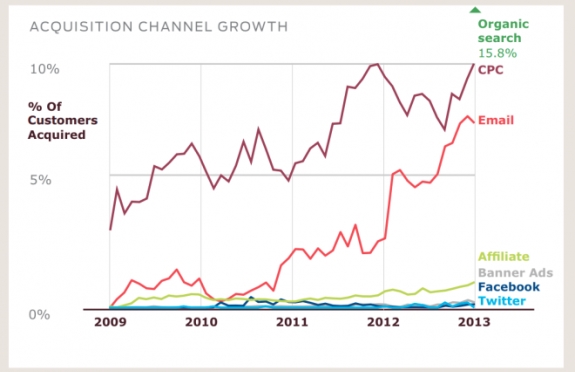
Trend in performance of digital channels for acquiring new customers
Custora came up with these figures by analysing data from 72 million customers shopping on 86 different retailer sites. They tracked where customers were clicking from (email, Twitter, Google, etc.) and what and how much they bought, not just on that visit but for the next two years.
Over those two years, Custora found that customers who came to retailers from search were 50 percent more valuable than average. In other words, they were more likely to shop more and spend more. Email customers were nearly 11 percent more valuable than average. Customers who came through Facebook were just about average. Twitter customers, meanwhile, were 23 percent less valuable than the average during the two years following that first click.
I've written before that our reluctance to spend clients' money on banner ads is based on one amazing fact: you are more likely to win Lotto than click on a banner ad.
In comparison to these digital channels, research by the Direct Marketing Association shows you may still be best served with good old direct mail:
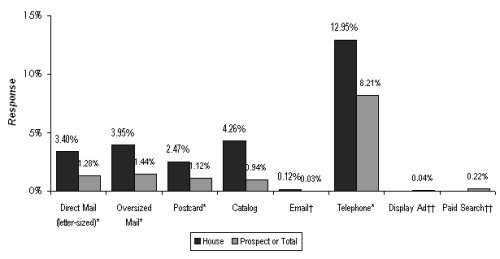
Average response rates for direct sales, DMA 2012
There is one new piece of research though that ultimately makes the discussions about differences between media effectiveness become a secondary consideration. It's proof of what many of us have always suspected.
How you craft your message is more important than the medium
The latest research into advertising effectiveness in Australia has proven creativity makes a big difference. The Association of Data-driven Marketing & Advertising shows that after 12 months ads with better ideas are both more effective and increase a brand's ability to harden pricing.
This reminds us you’re potentially wasting your time and money if you don’t get your pitch right. As consumers we remember big ideas, like “Think small.” Or the pulling power of a well crafted headline like “It’s Time.” Or a picture worth a thousand words...
The truth well told has been proven yet again to be more important in getting the best ROI from your marketing than any optimisation techniques digital specialists may dazzle the bean counters with. We are not animals, we are human, and we respond to emotions, not numbers of targeted exposures.
For those who want to make the most of their investment in airtime/space/or face-to-face, remember to invest a little in the art of communication.
It's not just consumer brands that can benefit from better communication
An ability to express your message is just as impotant for both service businesses and B2B. This is especially true for financial services, as shown by this chart of what customers say are the most important qualities in a financial adviser.
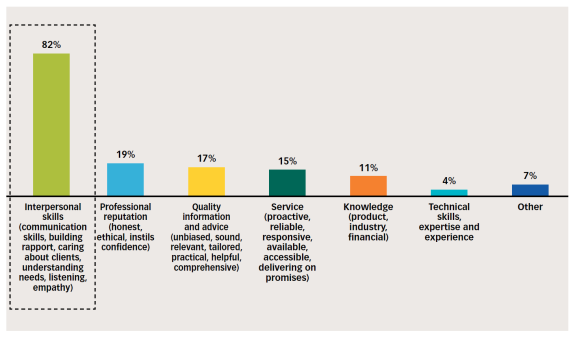
AFA White Paper: The Trusted Adviser May 2013
The report found the biggest difference in success of the top 10% of financial planners and the rest isn’t expertise, or credentials or technology – it’s the ability to communicate. Communication is not talking at people, it's the art of speaking with empathy. This is where social media excels. Use it to listen to your customers, then respond in a way that makes the individual believe you understand where they are coming from.
Irrespective of digital or traditional, face-to-face or in writing, where you have the conversation is secondary to the way you express yourself.
Just remember to make the message suit the medium. Our burping cow ring tone for Sipaah was downloaded by lots of kids who knew exactly where our brand was coming from.
Read MoreFame is the game of the name


The exponential pace of change is increasing the pressure on businesses to stay competitive. You know it’s not going to slow down. Fortunately there are still ways you can take control. One proven method is to revisit some simple building blocks to help make your brand relevant in today’s complex marketplace.
4 step process to make a challenger brand famous:
GAME
NAME
FAME
CLAIM
Game:
When did you last define what it is you do you do that makes you a specialist. In a cluttered business environment it pays to play in a defined niche where you know more about the rules of the game than your competition. Define the things that are of value to your prospect. Make sure you understand what it takes to be world’s best at your game, and work to stay at the top. People will still pay you a premium for something special that means something special to them.
With a fresh outside perspective, define your true differentiators, your “authentic truth.”
Name:
Your reputation, the brand and everything it does must be aligned with what you do that is special or your efforts will be diluted. Today, any business with integrity can compete against established incumbents. The cost of entry is no longer big budget mass media campaigns, the spoils now go to the nimble.
Today, the truth is what counts, the public can find the facts faster than businesses can attempt to shape opinion. Ensure your brand reflects your truth in everything you say and do.
Fame:
The art of being noticed. And remembered. And talked about.. You can do this several ways. Spend a lot of money, like Swisse, who invested up to 60% of annual revenue to marketing to achieve business growth, which stands at about 50% year-on-year over 4 years.
Or take the stand out in the crowd approach. An elevator pitch is only of value if people are listening, be too polite and you will be invisible. There is something to be said for the fart in a lift approach, however can you risk going viral with the wrong tone of voice?
Ideally, you can take the hero approach: be noticed by the right people for the right reasons. To do this ensure you choose the right medium for your message. There have never been so many communications options – a pitfall for the unwary, and an opportunity for the savvy
Claim:
Tell the truth, especially now the customer can search the Internet to discover what is a genuine claim and share with their friends what they find out. Decide what will differentiate you in your game – do you do it faster or smarter, cheaper or better?
Then find a creative way to express your difference. As J Walter Thompson said almost a century ago, “the truth well told” is the value add of great advertising.
Famous campaigns start with a defined customer benefit
What’s your “Which Bank?” How will you enter the vernacular, as this one of mine did 25 years ago:

With a creative leap, you can express the human insight that will resonate with your prospects. And they’ll repeat it to friends, again and again.
Read More

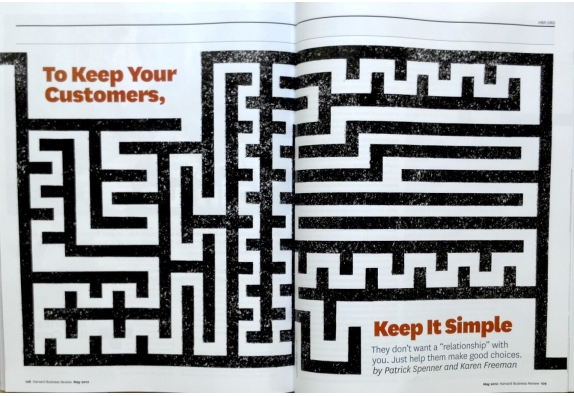
How do you explain to the manager who signs off your budget that today customers want more from your website than a brochure online? You can start by pointing out how you can replace existing fixed and recurrent costs with keener priced digital alternatives. Then remind the cost controller that technology is moving so fast they’ll be surprised how much more you can do today for less. A lot less than many of the savings to be made across existing business practices that digital can now enhance or replace. This 12 point digital checklist can help you keep it simple and the returns substantial.
Your digital project 12 point checklist
Keep an open mind, what the site needs to include is based on what the customer wants, don’t limit scope by prescribing whats to be included by your what your preconcievd ideas of what the competition have already done.
Engage with the user in the context of where and how they are accessing you. Are they on a mobile while in a shop, in bed on a tablet or at their workdesk on a PC? At work, at home, on the move, your site experience needs to change accordingly.
Educate or entertain? Ask yourself are they visiting your site to learn more, or simply because it is an enjoyable experience? Or would they like it if you did both? Deciding this helps shape your content and navigation.
Personalisation. "Allow users to personalise their experience. People love to add personal touches because it helps them feel at home and in control. Provide sensible, beautiful defaults, but also consider fun, optional customisations that don't hinder primary tasks." - Google Android
If you don't treat each customer as an individual, a competitor will. Technology now enables you to serve each visitor exactly what they want, a bespoke site just for them.
Innovate.The digitisation of everything now allows you to reinvent so many of your business functions and methods, take advantage of what is now possible.
Tone of voice is more important than what you say. The way the site looks, the colours used, typography, whether there are pictures or videos and the style of vocabulary you use will make a bigger impression about your brand image than what is in the text.
Services is what you build today, not websites. "Our service doesn’t begin and end at our website. It might start with a search engine and end at the post office. We need to design for that." - GOV.UK
Iterative, our most used word to describe our process for scoping, designing and building a digital service. Start small, constantly evolve and develop the service offer. We learn and improve the offer together as we go.
Marketing. A site without marketing is an island resort that’s not on any map, let alone an itinerary. Don’t launch and leave, have a plan that will drive customers and prospects to your site, align what the promise is and how your site will deliver to expectations.
P, there are 4 of them in marketing: Product, Price, Promotion, Place. Consider which of the Ps is most useful to enable you to best engage with each type of customer. The 4Ps of marketing aren’t all the same for every person or every occasion.
Load time is more important than looking good. Too many fancy things can slow down the experience.
"Make important things fast: Not all actions are equal. Decide what's most important in your app and make it easy to find and fast to use, like the shutter button in a camera, or the pause button in a music player." - Google Android
Effectiveness. Know what you want to achieve and why. Most importantly decide how you will measure with meaningful metrics that can be acted upon. Then you can build in measurement techniques to track what is working and what needs to be improved. And make sure someone is in charge of tracking results and implementing improvements.
If in doubt about what matters most, remember the customer's perspective comes first. Look at the first letter of our 12 points. In an increasingly complex world, when you connect with customers they will appreciate it of you can KEEP IT SIMPLE.
Read MoreRadioactive ads from when people didn't know better

Classic ads from 1910-1930 for radioactive products
What can’t radium cure? A century ago it was legal to advertise radioactive products, from toothpaste to suppositories, condoms and check out the chocolate!

If looks could kill: Radium lipstick advertisement from the 1930s. (via 109.com)
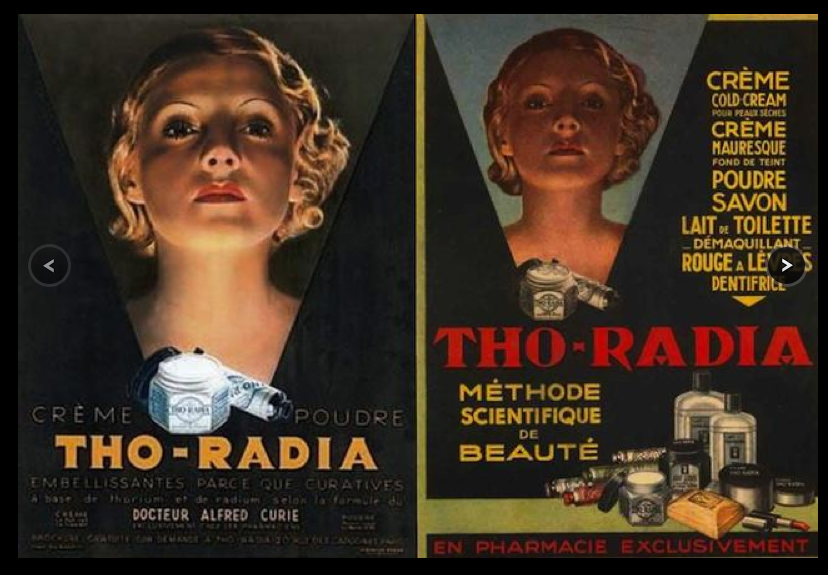
More classic ads from the 1930s for the Tho-Radia range of makeup.

Nil by mouth, guaranteed harmless?!! Gives new meaning to "the ring of confidence"

Anyhow, have a radium.

Now in a convenient pocket size pack of 20s. They didn't know smoking kills.

Mrs Marsh could give us a demonstration of the brighter effects on your smile of Radium toothpaste.

Chockaholics aren't left out, Radium is everywhere. The ads claimed eating a block would make you look younger.

Time wasn't on the side of those with radioactive numbered watches that glow in the dark.

Another ad campaign competing for share of the toothpaste that glows market, now with added thorium.

Radioactive wool keeps you warm on the slopes.
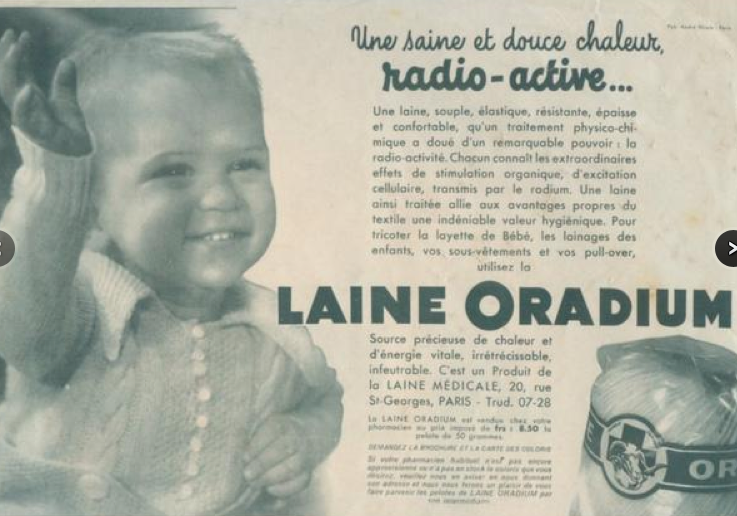
Dress your baby in it.

Advertised as a cure for arthritis, rheumatism, mental illnesses, stomach cancer and impotence. (via Real Food University and Oak Ridge Associated Universities) Triple distilled, who needs a whickey chaser?
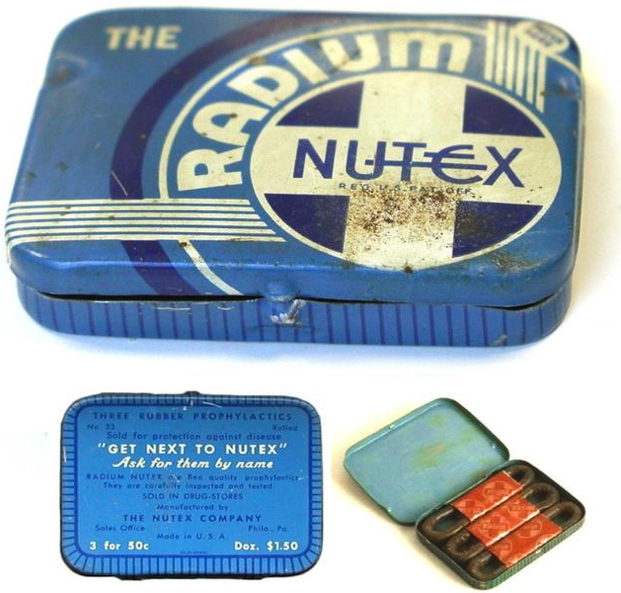
Condoms, that glow in the dark?
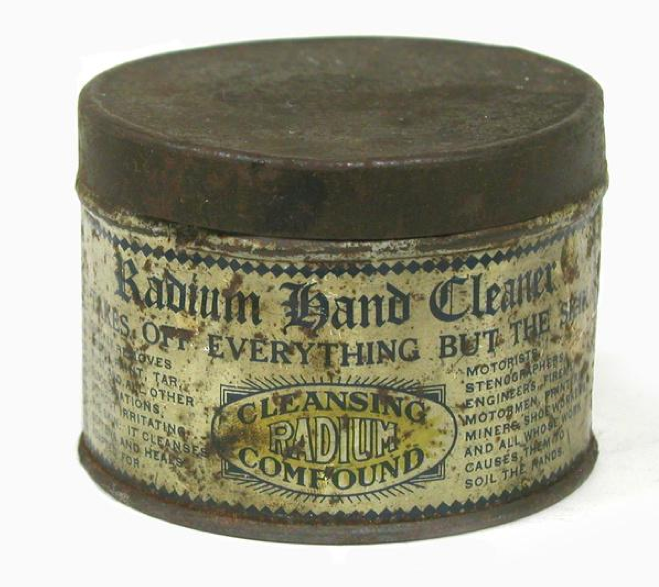
They didn't realise you can't wash off radiation poisoning.

Dr Curie started something big. Cosmetics companies continue to claim they have the secret to eternal youth.
Like to see some more classic ads?
Have a look at 12 great vintage politically incorrect ads for Christmas gifts.
Read More

Everyone knows the way to lose weight is to eat less and exercise more.
Yet year after year most Australians are getting fatter. Fatter people aren’t as healthy. Fatter people die earlier than fitter, leaner people.
A whole industry makes money out of fat. Fitness clubs. Personal trainers. And diets. None of it works over time. The stats prove it. It’s not enough to know you have a problem. Personally I have never been better educated, yet I’ve never been so overweight.
Science has shown only cognitive behavioural therapy ensures long-term positive change and a healthier longer life as an ex-fatty. 21 days of mind reprogramming is just the start to breaking the usual fatso habits.
Business as usual doesn’t work. How long till the business you work for dies?
Australian businesses are fat. They aren’t fit enough to cope with today’s rapid pace of change and increasingly complex issues. They don’t exercise their brainpower by trying something new. And like most of us with a weight issue they are looking for the quick fix. So they outsource it.
The diet industry equivalent in this instance are the service providers, from the Deloitte pre-prepared meal programs and the peddlers of management boot camps, to the efficiency fitness trainers selling the benefits of Sigma 6 and Lean. Even the language is the same as The Biggest Loser.
The answer for struggling businesses isn’t in doing the same things more often, or paying more personal trainers to lift your motivation. Nor is it enough to reduce the excess fat by cutting costs. Stomach stapling the business results in staff suffering reflux, hunger pains and mental stress for no performance improvement.
The answer is cognitive behavioural change.
The answer is developing an innovation mindset.
Here’s how it works and why most businesses are doomed to die early.
It starts with the owners of the business recognising they have a problem. An attitude problem. Their brains have been thinking the same way so long their synapses have turned a well-worn groove into a rut of superhighway proportions. The problem is, it’s now a road to nowhere.
The new business opportunities aren’t where the brain has become accustomed to drive to, every category is seeing their marketplace become a ghost town. Today’s marketplace is somewhere new, and management not only don’t know where it is they don’t have a map to show them how to get there.
The new destination is growing, profitable and exciting. It’s enabled by the Internet and feeds on new ideas made possible by software as a service, unified comms and the cloud. The new place isn’t a city or a country or a category, it’s everywhere and anywhere the customer happens to be, 24/7. Now every customer or prospect can pick and choose what they want via a mobile device. From cat food to cars, retirement plans to restaurants, you can research and purchase without talking to a salesperson.
Yet business owners continue to think the value of their business is existing fixed assets and legacy systems, current supply contracts and distribution arrangements, proprietary processes and procurement systems. Australian managers continue to tweak a little here and there around the edges of their business models. Generally, the bigger the organisation the more cholesterol blocked the arteries of internal management and external communication.
Figuratively speaking, fat dead men walking the corridors of offices around the country are about to be knocked off by fit and nimble female and new age male entrepreneurial thinkers who are open source and open minded.
So what do our business leaders do? They buy another diet book, like the biography of Steve Jobs. What they don’t realise is reading about Apple is as relevant to middle managers as middle aged men reading about Usain Bolt’s exercise regime. Apple was a challenger brand from day one. It was in the DNA.
The answer isn’t reading a book on what someone else has done. It comes from doing what hasn’t been done. It comes from the confidence to try something new with a willingness to fail. Accepting you’re likely to fail again and again. Because continuing to do what you do now is guaranteed to fail. While with every new thing you try your chances of discovering a winner increases.
Changing your habits and practicing to do what doesn’t come naturally, every day, is the proven method for success. It’s making a habit of taking small risks often so you don’t stand still and become another Kodak. The proof is in understanding how Fujifilm could innovate itself a future as a cosmetics company.
Memories might be priceless, they just don’t make money like they used to.

How a traditional business became a challenger brand
Fifteen years ago Kodak entered a death spiral, from a global peak in 2000, camera film sales dropped 90 per cent in 10 years as the digital revolution swept the world. “We’d known it was coming since the 1980s,” says Yojiro Yamashita, general manager of Fujifilm’s life science products division.
Kodak didn’t make it, going bankrupt last year. Fujifilm not only survived but emerged into the digital world of today with a series of innovative new businesses.
Fuji recognised what its’ true strengths were says Tomoyuki Yamazumi, a cosmetics industry analyst for the research firm Fuji-Keizai. “It had the financial power plus a strong marketing ability and existing ties to consumers.” One of the small risks Fuji management took was launching a cosmetics range in 2007. By 2010, sales of Fuji’s upmarket Astalift brand were already over $100million a year. By 2018 the company is looking to increase skincare and supplement sales by ten times that.
Look around your business. Are you a Kodak, or can you recognise your strengths, try something new and innovate your way to a future as a challenger brand?
This article first appeared in AdNews, 30/5/13
Read More

At CeBit 2013, Salesforce Vice President Vivek Kundra’s big question for Australian leaders is “how can a country of 22 million people compete in a world of seven billion?” His answer?
“It’s not about size. It’s going to be about innovation. Innovation policy and an innovation agenda have to bethe come building blocks of a nation that’s going to compete in the global economy.”
Third wave of computing is changing the global economy
Competition in the global world of business is being driven by a ‘third wave of computing’. Essentially the shift from hardware to cloud based software and services and super fast mobile broadband networks that allow consumers and workers to access data on portable devices. Our clients have seen a doubling of visits to their websites from mobile devices over the last year. In fact, this year more people globally will access the Internet from a mobile than a computer.
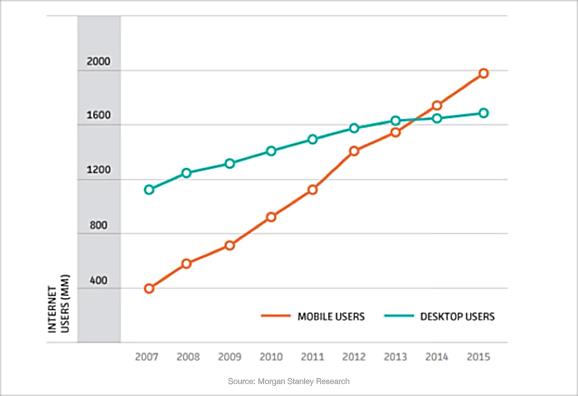
The opportunity for challenger brands
The biggest risk for businesses I’ve observed are the internal stakeholders defending their hard fought for legacy systems and infrastructure, and managers who are obsessed with efficiency through fine-tuning traditional methods. As Kundra points out, competitiveness now comes from letting go of what you’ve currently got now. “Most large scale organisations are still stuck in 1980s technologies. If you’re still stuck in an old mindset then unfortunately there’s a young entrepreneur who is imagining the way the world should be rather than it is.”
“The most amazing opportunities lie in reinventing entire sectors of the economy.” Vivek used the usual examples of US companies like Amazon, Netflix and Uber as businesses that are challenging categories today.
If you are running a business you have a clear choice he says – “do you want to be Amazon or Barnes & Noble?” This isn’t a particularly new view, as a global survey by Boston consulting summed up a couple of years ago, in this world of rapid change the spoils go to the nimble. Still, many managers still don’t seem to be responding.
“There’s a Darwinian spirit to the extinction of those who are holding onto the 1960s ways of doing business.” Vivek states, “not because it’s in the interest of the customer but because it’s easy and it’s because that’s what they know what to do.”
A marketer’s mantra for today: “The customer. The customer. The customer”
This is the biggest differentiator for challenger brands. “Companies that are embracing the third wave of doing business are doing it in the interest of the customer.”
Kundra recognises the fear of change within businesses when he suggests the best way to introduce a change culture is to build a prototype. “I think for too many people the expectations for transformative technologies is that it takes too long, costs too much and they’ve been burned in the past.”
A test and learn approach reduces risk
Last week at the launch of an AGSM Mid-Market program a professor specialising in innovation for business pointed out success today comes from having a portfolio of new initiatives that can be tested quickly in the marketplace. Rather than over researching only one strategy in an attempt to minimise risk, be willing to fail and fail frequently. The chances of some prototypes being winners with the customer will increase the more you try.
As Kundra says, aim to “be relevant and simplify the customers’ or citizens’ lives”.
Read More

The latest statistics on online fashion retail sales, research on the main purchase driver for financial advice and a Californian think tank pricing model all give marketers strong reasons to reconsider Price as a useful tool.
Evidence 1: Online fashion sales prove price not the motivator
No wonder Australian retailers are scared of online stores. British online retailer ASOS recently revealed that Australia is its single largest foreign market — with Australians buying something from the ASOS website every 6 seconds. The latest research from Roy Morgan shows at December 2012, 7.6% of Aussies aged 14+ (or 1,430,000 people) had made an online fashion purchase in any given four weeks — up from 5.7% (1,062,000) one year earlier.
Online fashion-purchasing habits by Australian women by sub-category, 2011-2012
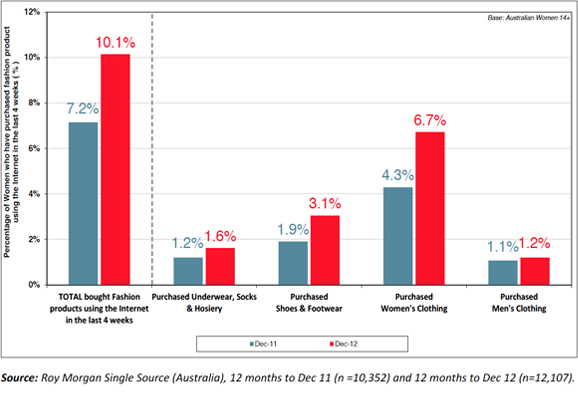
What is really interesting is the opportunities for marketers this research reveals. Most people would probably jump to the conclusion that these online sales are being lost by Australian stores because clothes are available cheaper from overseas. Everything on the web is cheaper, right? Well actually, no.
Roy Morgan’s research has found “scoring a bargain is not the main motivation for women purchasing fashion products online. Far more important is quality, with 75% of them agreeing with the statement ‘I believe quality is more important than price’.”
Discretionary spending by women on clothes has parallels with the way men seek financial advice. A recent national survey by an independent network of financial advisors found the vast majority of customers were more concerned about the quality of service and the frequency of face-to-face time they received than the size of the fee. Of hundreds of customers surveyed, price was rarely mentioned. Value was the primary concern, and the value equation was grounded in the perception of the quality of advice. .
None of this is new. I’ve been segmenting customers using the New Economic Order for nearly two decades since it was first developed by two Australian academics.
Evidence 2: choose who you want to be your customer
You can segment the population by three distinct sets which allow marketers to predict discretionary spending behaviour. The biggest segment, the Traditionals, sre generally cash poor with most of their spending accounted for with essential services, utilities bills, rent, transport and food. They have neither the capacity nor the predisposition to purchase discretionary items.
The other half has a common mindset, they share a desire to buy quality goods and experiences. This group is divided in half by their capacity to spend, one half are NEOs, and while they are only a quarter of the population they represent half all discretionary spending. Transitionals are NEOs on a limited budget: a career couple with one at home with a baby, or a high achiever that's just started their own business, or perhaps they have retired.
For 50% of consumers, the Traditionals, a cheap price is their opening and closing consideration. However these are the people who don’t spend much. They also deliver no sense of loyalty and don’t refer new customers. Every sale to a Traditional is a new sale that starts from scratch. And risks going to the lowest priced competitor on the day.
Most restaurant and airline customers and B2B purchasers are NEOs. These people research purchase decisions on the basis of what they believe are the features and benefits that mean the most to them. Price comes LAST, and isn’t much of a deal breaker.
Those latest stats on online fashion sales make sense in light of NEO behaviour. NEOs are online researching what’s hot in the world of fashion. In fact, it’s where they do most research when considering any major purchase because it’s where they control the levers, avoiding the unsavoury hassle of being sold by a salesman face to face. While Traditionals continue to spend the majority of their clothing budget on essential items like socks and undies in stores when the sales are on, NEOs continue to buy more discretionary fashion items, more often, both from the Internet and instore.
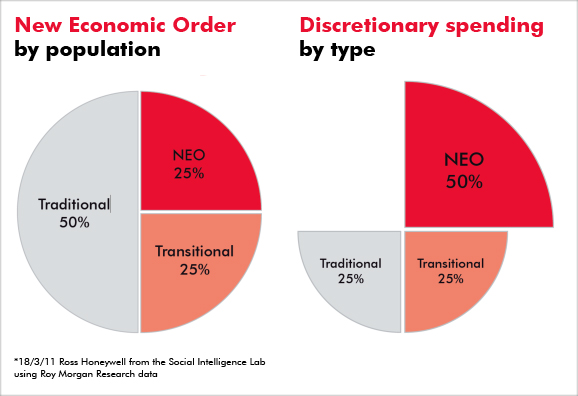
So what’s the best marketing model for selling to NEOs?
Evidence 3: all value is subjective
According to Ron Baker, the founder of Californian think tank the VeraSage Institute there are two fundamental approaches to pricing:
Cost-Plus Pricing
Labour Theory of Value
Product » Cost » Price » Value » Customers
Pricing On Purpose
Subjective Theory of Value
Customers » Value » Price » Cost » Product
You can see how subjective value pricing turns the order of cost-plus pricing on its head, by starting with the ultimate arbiter of value – the customer. In Baker’s words: “Goods and services do not magically become more valuable as they move through the factory and have costs allocated to them by cost accountants. The costs do not determine the price, let alone the value. It is precisely the opposite; that is, the price determines the costs that can be profitably invested in to make a product desirable for the customer, at an acceptable profit for the seller.”
As a marketer, for decades I found software one of the simplest products to approach from the Pricing On Purpose model; it’s the only reason Microsoft had education, standard and professional versions. The mid range product best reflects a fair margin for the cost of production of the product. The same product is then also sold at a low entry price with a few features turned off to maximise sales volume at the low end and repackaged in a fancy big box with a few extra features to maximise margin at the upper end of the market.
Choose who you want your customer to be, only then pick a marketing P
Whether you are selling clothes or cars, fair trade coffee or boutique wine, building materials or investment services, remember when your sales force wants you to discount, ask them to stop and think about the customer. Are you selling a basic product to a student, an authentic experience to a Transitional or a professional service to a NEO? Agree with sales who your customers are before you decide to use the PRICE lever.
Depending on who your customer is, Product, Place or Promotion may be more valuable to them than Price.
Read More

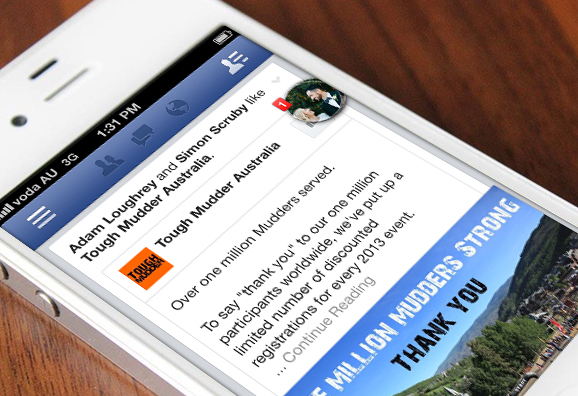
Just being active on Facebook isn’t enough. As with any communications medium, there are smart ways to achieve more for less effort.
Don’t be baffled by social media marketing spin doctors. Sure, Facebook has it’s own set of best practices. Hopefully by getting to know what matters and what doesn’t you can ensure any supplier will make the most of your investment.
The key to making the most of Facebook for your business is understanding it’s all about making sure everything you do improves your chances of being seen.
Much of this isn’t about paying for black art, it’s about basic step by step craft.
40% of time on Facebook is spent on news feeds
Only 12% is spent on profile or brand pages. So:
- Post articles on other people’s pagesPost on less pages more often
- Choose pages with high numbers of fansPhotos have higher ranking than links or text
- Use images
- Keep your text posts short – between 100 to 250 characters get 60% more engagement
- Ask a question
- Post daily and frequently
- Post about relevant topics – don’t push the brand
- Test your audience for their engagement times – 18-24 year olds are most active 9pm – 10pm, women 25-45 even later
How edge-ranking works is the key for marketers
All of these individual steps are only important because of something called edge-ranking. This makes or breaks social media marketing. This infographic shows how it works.
Read MoreThe health checklist for your sales process

15 questions to help your business determine the focus for your sales activity.
Do you have a sales department? Here are 15 questions to help change your sales force from sales takers to sales makers:
- How much time are you investing in new business a day?
- Is the total revenue and the sum of your clients’ budgets growing more slowly than in the past?
- Will growth levels come from present client budgets?
- Where will growth come from?
More frequency of purchase
More volume of each sale
More value? Up sell/or cross sell? - Will growth have to come from new business won from competitors?
- How do you sell to prospective clients?
- What’s your process?
- How do you find them?
- How do you win them?
- How do you prioritise sales calls?
- How is a sales call pre-qualified, (telesales/email/CRM)
- How long is spent face to face?
- What is your conversion rate?
- Is the sales call to the final decision maker?
- Who is the primary decision maker, how are they managed?
ROI marketing can help improve the performance of any of these sales metrics.
Marketing can speed sales, pre-qualify and build loyalty once you’ve made a sale.
In the past business owners were frustrated by an inability to measure what worked and what didn’t. Today there are tools and technques to enable you to measure the return on your marketing investment.
Read More$2M+ of lies to win power

I believe in truth in advertising. So does the commercial TV regulator that demands evidence for any claim you want to make before they give your ad clearance to air. Unfortunately for the voters of NSW, political parties are allowed to say what they want in an ad because they aren't answerable to any of the rules mere brands and businesses have to conform to.
If I made a fraudulent claim for a client in an ad, (for instance the kind of price saving offer mobile phone plans were notorious for before being fined into transparent pricing), the ACCC or ASIC would come after me. This election has seen Labor and unions spend twice the Liberals. Most of that $2,500,000 was on ads that say electricity prices will go up if Baird sells 49% of the poles and wires. It's a lie.
Their ads scream this lie despite ACCC chairman Rod Simms saying this isn't the case. Even the Australian Energy regulator is on record that whoever owns the poles and wires in NSW after the election he will insist they reduce their prices by 20-30% over the next five years. There is no evidence for the claim made in Labor's ads that I believe would have satisfied the broadcast standards that commercial advertisers have to comply with. In fact, there is much historic evidence from previous power privatisations showing prices are lower outside government ownership. This has been acknowledged by such Labor luminaries as Bob Carr, Morris Iemma, Michael Costa and Anna Bligh when they attempted to sell the poles and wires under their governments.
It frustrates me as a professional marketer that in the 21st century political parties of any persuasion can play 1984 mind games with the truth and run them in prime time. The ABC Fact Check merely called Foley's ad pitch "spin". I prefer the robust language of former Labor Energy Minister and ACTU president Martin Ferguson. He says Foley's spin is "rank opportunism and scaremongering... sending a clear message he doesn't care about jobs and energy security."
Politicians' ad claims are officially accountable to... themselves
Here is the law (or lack of) that applies to political advertising as published by adstandards:
"Currently, there is no legal requirement for the content of political advertising to be factually correct. Complainants are advised to raise their concerns with the advertiser directly and/or with their local Member of Parliament."
Maybe we should just ban political advertising, we banned cigarette ads for telling us porkies.
Read MoreThe optimum lengths of social media
People now have short attention spans. So to connect you have to cut through. Keep it honest. Keep it simple. And keep it true to your brand. As for length, keep it short.
71 - 100 characters
Posts with 40 characters get 86% more engagement
Google+
25 characters
40 characters
Linked In
Posts 16 to 25 words long
Videos
Average length watched is 2.7 minutes
Read MoreThe average customer has an attention span of


How does a brand catch a customer's interest when their attention span is now less than that of a goldfish? I spent a few seconds Googling to discover the average person's attention span has shrunk since 1998, by 11 minutes.
The average attention span today is 8 seconds
The National Center for Biotechnology Information says our attention span is now 1 second less than goldfish. What hope does a brand have to convince us to buy?
Consider a tube of toothpaste. The average main grocery buyer now spends less than 20 minutes in the supermarket for the big weekly shop. With over 10,000 items to choose from it's not surprising when faced with so many options brands are struggling to catch shoppers' interest. At the dental care section 27% of shoppers walk away without making a decision.
You may be aware Australians have never been better educated, the number of university graduates has almost quadrupled since 1986, from 6% to more than 21%. Are we any smarter or better prepared to make purchase decisions?
We are exposed to five times the quantity of information every day than we received 30 years ago, (you may be surprised just how many ads we are exposed to). Yet we have less free time to consider. The Economist explains that time poverty is a wealth syndrome, the more money we have the more we value our time and the more choices we are confronted with to spend that time. At the other extreme, cash strapped people have largely given up trying to decipher so much information, they are influenced by price like never before.
Price is increasingly winning over brand appeal. It's at the heart of the growing success of ALDI – less items to choose from, mostly unbranded, all at lower prices. This has seen their share of grocery sales reach 10%, a big slice of the market brands are mostly missing.
Even brands are struggling to be seen in Woolworths
According to Woolworths own research "more than a third of the items in Woolworths’ supermarket trolleys are purchased on promotion." That's an increase of 10% a year for the last two years.
"Australians hunting for bargains are the big winners, with one in four customers (25%) purchasing nearly half of the food and drinks in their trolley on special."
How do the retailers manipulate the time poor if not with price?
One journalist recently warned shoppers something brand marketers pay dearly for:
- The most expensive brands, or the ones being promoted heavily, will always be on the two shelves that sit between waist and shoulder height.
- Cheaper products are often stocked below knee height.
- Supermarkets know that you may only want milk so put it at the back of the store in the hope you’ll pick up items you don’t need.
Not only are the retailers asking brands for price rebates, Private Label substitutes are also catching once impregnable brands in a pincer movement. So if you believe in protecting the value of your brand you'll probably want to avoid discounting too often. Only the biggest and most desperate can afford to pay Coles and Woolies to be on promotion. In the past sales managers have encouraged the benefits of putting products on promotion to drive sales. Does it still work in the era of short attention spans?
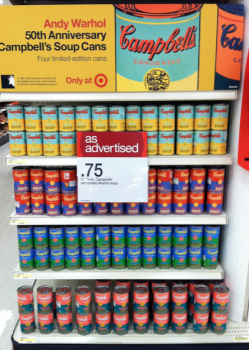
My associates at consumer benchmarking specialists B4P spent a year researching the impact of sales promotions at Point of Purchase (POP). The clients were several of the largest global FMCG companies that are active promoters in Australia's supermarkets, every week of the year. They tested awareness before promotion, cut through in-store, trial, impact on sales and recall several weeks later.
Across all promotion types, (price promotion, competitions, bundled offers and bonuses), shoppers generally don't notice any of it. This is despite multi-million dollar spends on displays, cardboard, posters, banners, gondola ends and shelf strips. Most in-store promotions have become invisible.
Earned and shared media can still gain attention
As we learned over seven years growing Pacific West from a $6million pa frozen seafood minnow to a $38million challenger brand, you can drive shoppers to your product by creating original content to tell your story and social media to spread the word. Just remember your audience has a short attention span. Here is a charming infographic that shows the optimum number of times to post content on social media channels.

Read More
Think big, or detail will kill your business


"Look, I said I'd bring you the report on micromanagement,
just give me a minute!"
Stop sweating the small stuff, especially now there's so much of it. New technologies allow us to gather data on just about everything. So it's become accepted practice for marketers and sales to invest in new ways to gather stats and report to senior management. For those of you wondering what's the point, it has now been proven the more a business spends on technology, CRM systems and sales data, the less well it performs in profitable conversions.
The more technology marketers use, the worse the results
Sounds like a contradiction, but the research undertaken by Peter Strohkorb into sales and marketing collaboration in 2013/4, simply proves the more systems teams add the worse the sales results. It's symptomatic of what the authors of Blue Ocean Strategy postulated over a decade ago. A typical strategic plan is usually based on a plethora of research from silos across the business which forces management to dwell on detail. Management becomes paralyzed by information overload.
The businesses that thrive are the ones that step back and look at the big picture using a customer centric view of what could be possible. Here's how it works.
Focus on the big picture to create a Blue Ocean Strategy
| Head to head competition | Blue Ocean creation | ||
| Industry | Focus on rivals within industry | Looks across alternative industries | |
| Strategic group | Focus on position against competitors | Looks across strategic groups | |
| Buyer group | Focus on better surving current buyers | Redifines who buyers can be | |
| Scope of product /service | Focus on costs/maximising value of current offer | Looks across complementary products/services | |
| Functional/emotional orientation | Focus on price/performance improvement | Rethinks the orientation of the industry | |
| Time | Reacts to industry changes as they happen | Participates in shaping external trends over time |
With a Blue Ocean strategy, you can implement a clear brand building campaign
We've found time and again, once clients re-visit what they can be, the task of growing the business becomes clear. Our methods to help create clear differentiation set the business up for challenger brand growth. With a single minded compelling tag line that sets them apart, big picture thinking helps refresh the business. There is new enthusiasm we harness to recreate the brand and relaunch. The way is now clear to become a price setter, not taker and drive sales conversions.
See some of the ways a refreshed brand can improve profitability.
Read MoreFor a nation of gamblers we're marketing risk averse
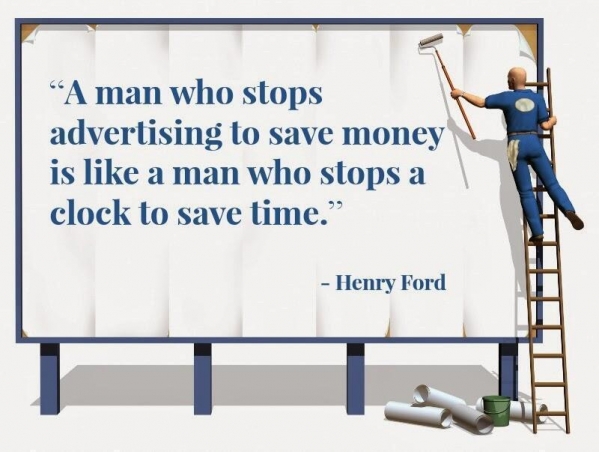
The companies that rated best for effective marketing, according to a recent Gartner study, were the ones that spent the most time understanding their customers. Businesses that are introspective and fearful of action will lose sales to those actively talking to customers and prospects.
How do you guarantee marketing success?
Jan-Patrick Schmitz, CEO of Montblanc North America, says "it obviously starts with the CEO. If he or she doesn’t understand that the business is about the customer and not operations, the CMO is going to have an uphill battle. Understanding your customer is about understanding what your business is and what your business will grow into.”
It's not a lottery, once you understand what customers want from your product or service, marketers that advocate for the customer in the boardroom will win.
Get the message right, then the risks are reduced irrespective of the mediums you then try. If you do understand your customers true needs and what they value most, and built your offer to satisfy those desires, it's time to check out the latest ways to advertise and connect.
Read MoreAussie business struggles, time for a creative way out


Will our kids ever be able to afford to buy a house? Can they even afford to rent? Here in Woolloomooloo 2 bed flats start at $1,000 a week, unfurnished! Unemployment is on the way up, mining investment on the way down. Coles and Woolies continue to squeeze farmers and FMCG brands while bricks and mortar retail is flat.
The big 4 banks are making record profits on higher margins than ever. If you are a small to medium business they probably won't give you a loan. 20 years ago 75% of bank lending was to business, now 75% goes to funding ballooning house prices.
This chart shows the decline in business investment post GFC
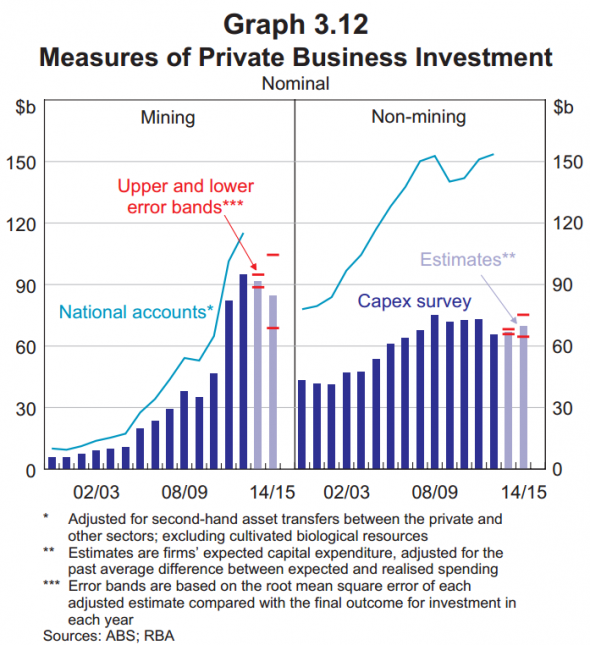
If businesses aren't investing in themselves, how can they grow let alone survive as the Internet destroys traditional business models?
Most managers have spent the last 6 years cutting and seeking efficiencies, hoping if they hang on long enough the market will recover. While local businesses seem to think it's conditions that are tough, World Bank figures show the world is booming – output was up $US75 trillion last year, which is about 20 per cent higher than the pre-GFC peak. 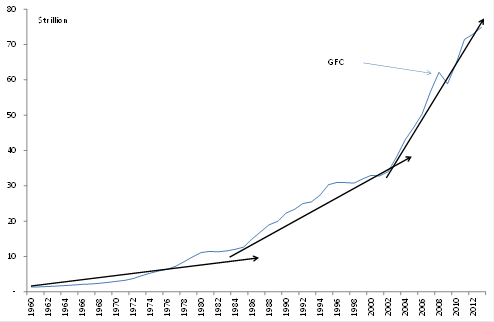
The world is moving on
Australians need to look outwards and recognise there isn't going to be a return to the way things were, the new reality is more rapid change and creative destruction. I use the word creative discerningly. It's the best way to describe the increasingly global competitive situation most businesses are struggling to get their heads around.
Historically change came slowly and could be managed by gradual adjustments of pricing, distribution or inputs. Not any more.
Enabled by the Internet, we now have Google replacing entire distribution channels with a search box. The Cloud has enabled brands such as Xero to offer with a lower cost and better service to leapfrog long established businesses like MYOB that relied on annual software upgrades. Social media has empowered determined consumers to "out" entrenched self-serving business practices, just look at CommBank's conflicted financial advice scandal that could cost it over $100million. (Or ANZ's Timbercorp scam and Macquarie's financial planners rort.)
These are all examples of a new business environment. New challenges require new thinking. A survey of over 300,0000 managers published by Harvard Business Review shows both CEOs and the next 3 levels of management aren't equipped to think outside the square.
The most important skills as rated by managers
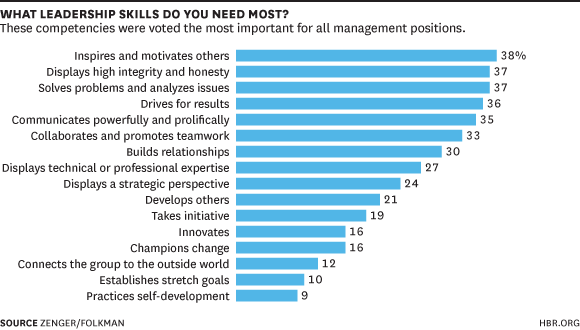
Perhaps the skills that are most needed today to deal with the rapid pace of change are the ones required to find creative ways to refresh and relaunch a business. Yet the survey found these are the least valued by management. Can you imagine how the people behind some of Australia's most successful businesses would rank themselves for the skills on the list? Like the young pair behind Atlassian, ten years ago a start up now worth $3.5billion. Or Boost Juice, Cochlear or Challenger, Seek or Xero. How important to their success are the more creative skills most managers in the survey dismiss?
Creative thinking skills
Innovates
Champions change
Connects the group to the outside world
Establishes stretch goals
Practices self-development
You may be interested to see evidence of how creative thinking adds value in this time of digital disruption. UNO helps challenger brands grow by encouraging and mentoring these creative skills that most managers have underutilised. Download our formula for growing challenger brands here.
UNO's one time client at Choice Christopher Zinn explains more on the new influence of the determined consumer.
Read MoreWant to see where marketing is headed?

Technology is changing everything in our world. Marketing isn't just following the trends, today marketers are actually more likely to be using new technologies to drive change within businesses than the IT department.
I wrote recently that Gartner has found the average CMO now spends more on IT than the CIO. It's all about understanding what the customer wants, then finding what technology can now do to give it to them.
Big Data driven future for marketers
Here is a chart I came across that helps explain where we are today and where we are heading. Sooner rather than later.
Just click for a bigger view of the future of marketing.
Read MoreWant a strong brand? Here's one we prepared earlier
What's in a brand name?
Money in the bank if you choose the right one, or an uphill battle and wasted dollars if you get it wrong.
Your business is your baby, and just like your first child, choosing a name can be fraught. Rather than show stats or a share a list of "most popular brand names of 2014" or cherry picked research to explain the pros and cons of what makes a good brand, I'm going to share 30+ years of trial and error and what it's shown me actually works in the real world. Not just what sounds good when shared with your spouse when working through the choices lying in bed late at night.
How a brand name change delievered a 3000% return
City Mutual had been around for over 100 years, yet onlythan 2 in 100 Australians recognised it. Three years later it was the best known investment and insurance group after AMP, having changed it's name to Capita.
Buying IBM means you won't get fired
Managers for decades have filled tenders, often at higher prices, knowing the board would never question the decision. Every time a client comes to me saying they want to call their business a series of initials they quickly use IBM as an example of why it will work. You can forgive their missunderstanding of what makes a brand. Unless your over 100 years of age you would necessarily know International Business Machines gained it's reputation for deivering reliable and ofte leading edge typewriters and for fifty years before it abreviated it's name to the initials that sat kneatly in the corner of millions of machines in office desks around the world. Today they business is in consulting, so Business Machines wouldn't be apt.
How to make a splash
Local businesses need to think of global consequences
When IFX Markets, a UK listed financial services business wanted to test market a business model in Australia for global roll out, the question of the right name came up very early in discussions.
Read MoreHave Aussies forgotten how to make things?


If you're anything like me, you enjoy a weekend trip to Bunnings. Today there are more things to buy than ever, for less than when our fathers took us to the local hardware decades ago. Where once tools and taps and barrows and bolts were manufactured in Australia, most of this stuff is made in China.
Most of us would agree Australia's manufacturing sector has been destroyed by cheap Chinese imports. What hope is there for Australian made? With the help of some lateral thinking, maybe more than most think.
The end of the made in China boom?
Robert Gottliebsen reports China's remarkable gains in productivity and standards of living were all achieved with borrowed capital and technology. Alan Greenspan points out that no Chinese companies feature on the annual lists of the world's most innovative companies -- nearly half of those lists are made up of American companies. This is leading to a narrowing productivity gap between China and the US, which is putting serious pressure on the Chinese economy.
That's right, don't underestimate the power of first world creative thinking when matched against the cheap cost of third world manual labour. Here are a couple of examples from my dealings over the last year.
Australia leads the world in compression fabric design
 I remember twenty years ago most Australian clothing manufacturers closed their local factories and set up workshops in Fiji where labour was cheap. Now most clothes sold here, even in stores like Zara, are made in China or Pakistan by one suspects slave labour. Yet in some areas of fashion we continue to lead the world.
I remember twenty years ago most Australian clothing manufacturers closed their local factories and set up workshops in Fiji where labour was cheap. Now most clothes sold here, even in stores like Zara, are made in China or Pakistan by one suspects slave labour. Yet in some areas of fashion we continue to lead the world.
Our client Quick Response is a local family business of almost 20 years who are still designing and making swimwear and compression garments locally. What's more, they manufacture using Australian made fabric.
In fact Australian compression fabric is the most technologically advanced in the world. It's the result of research and innovation that over the years has been tried and tested by our champion swimmers in those body hugging suits.
UNO have built an e-commerce site so you can buy the world's-best QRS compression garments direct, for less than sports brands that are usually made in China and Indonesian from inferior fabric.
Still open: a local manufacturer of timber shutters
Thirteen years ago Open Shutters was one of UNO's foundation clients. While cheap Chinese shutters have decimated most local manufacturers, Open continue to do business by concentrating on innovation. An obsession with quality design, investing in advanced machinery and only using sustainable timbers continues set them apart.
While white paint may disguise the compromises of Chinese made shutters in the short term, having been in the market now for several years they are proving to peel, bow, crack and break. The fact Open's product is built to last sees them gaining repeat sales over two decades on. What really makes the biggest difference is the way Open think: 
What truly lifts them to the top of their category in the world is the design thinking process they apply in everything they do. When suppliers tell local architects or designers their ideas aren't possible, Open finds a creative way to deliver.
Could robots save Australian manufacturing
If you still doubt the power of creative thinking over cheap labour, consider this. Last year McKinsey released a list of the things that would change the business world. Near the top of the list was advanced robotics: robots with better and better senses, dexterity and intelligence that can automate tasks or help humans or even operate on us more effectively than... humans.
To quote the numbers:
• 170%: growth in sales of industrial robots 2009-2011,
• 320 million: manufacturing workers (12% of global workforce), and
• $2-3 million: cost of the 250 million annual major surgeries.
Here's what robots could do:
"Advances could make it practical to substitute robots for human labor in more manufacturing tasks, as well as in a growing number of service jobs, such as cleaning and maintenance. This technology could also enable new types of surgical robots."
Closer to home, when I underwent keyhole surgery a few months back, I could have chosen to be operated on by a robot designed in the US for remote controlled surgery on the battlefield. My gap cover wasn't enough to cover the extra cost, but the cost gap will quickly close. It's another reminder the changes in our lives will more likely be shaped by innovation than the global oversupply of cheap labour.
If you are a manufacturer the message is clear, forget cost cutting, start thinking and get marketing.
Read more on how to rethink your business.
Read MorePerception or Reality? Customers now decide


Over 50% of people don’t trust financial advisers. So I was told on the news last night. If you have ever been to see an advisor you’ve probably come away with the perception that they aren’t telling you everything straight. Commbank’s multi-million dollar financial planning scandal has proved perception IS reality when it comes to advisors.
For decades when a business advertises a product, whether baked beans or an investment, the words and claims made are open to scrutiny and have to be THE TRUTH. You have to deliver on the promise or you are liable under a number of ad standards, ASIC and ACCC rules. If you sell a financial product face-to-face most of these rules don’t seem to apply or be enforced.
Big 4 Banks still traditional marketers
What the big 4 banks and AMP have got away with is a classic exercise in traditional marketing methodology – control the distribution channel and you control both pricing and product. By using different brands they have been able to sell the same products to an unsuspecting public. Most people haven't realised 80% of advisors work for groups owned or aligned with just 5 product providers.
Most people think they are seeking financial advice, when what they are getting is a sales pitch. How can anyone be given genuine choice when of 18,000 advisors only 31 are truly independent? We’ve all been buying Home Brand super for years and haven’t known it. Here is a list of just some of the hundreds of “brands” just 5 providers have sold their own products under:
Cavendish AMP
Charter Financial Planning AMP
Garrisons AMP
Genesys AMP
Hillross Financial Planning AMP
Ipac AMP
Avanteos Commonwealth Bank
Colonial First State Commonwealth Bank
Commonwealth Financial Planning Commonwealth Bank
Count Financial Commonwealth Bank
Financial Wisdom Commonwealth Bank
Witaker McNaught Commonwealth Bank
Apogee NAB
Garvan Financial Planning NAB
Godfrey Pembroke NAB
Lend Lease Financial Planning NAB
Meritum Financial NAB
MLC NAB
Elders Financial Planning ANZ
Financial Services Partners ANZ
Millenium3 ANZ
OnePath ANZ
RI Advice (RetireInvest) ANZ
Sentry ANZ
Asgard Westpac
BT Westpac
Pact Accountants Investment Group Westpac
KPMG Financial Planning Westpac
Securitor Financial Group Westpac
A couple of rogue CommBank advisors who ripped off investors for millions is just the tip of the iceberg of poor brand values. Ian Narev says the business won’t suffer. I suggest the era of brand equity built upon decades of million dollar perception-shaping advertising is over. The Internet has democratised the share of mind of customers. Does Narev not understand this? Instead of changing his business model he returned from holidays to push the button on a million+ dollar ad campaign trying to reassure customers they are fixing things. This old school reaction won't preserve brand equity long term. Here’s proof.
Try Googling CommBank financial planner. This is the result I got:
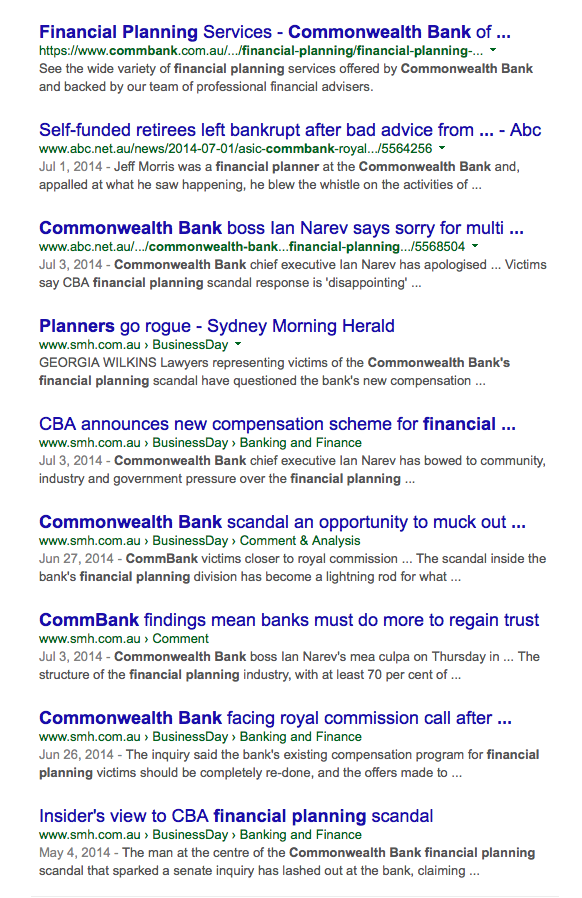
Last week we saw the government roll back the FoFA laws that were supposed to make hidden and trailing commissions illegal. Despite some wordy amendments from Clive Palmer, there is still no ironclad law that insists advisors can’t sell you a product because they get a kickback, not because it’s the very best choice for you.
Challenger brands will win with customer centric marketing
Legislation may not stop the consumer unfriendly practices of big banks. Social media and the empowered consumer will. And new technologies will see challenger brands that build financial product and service offers around what customers actually want will grow at their expense. Coles new deal with GE Capital to offer loans is just the start. I'll leave the last word to a consumer active on social media:
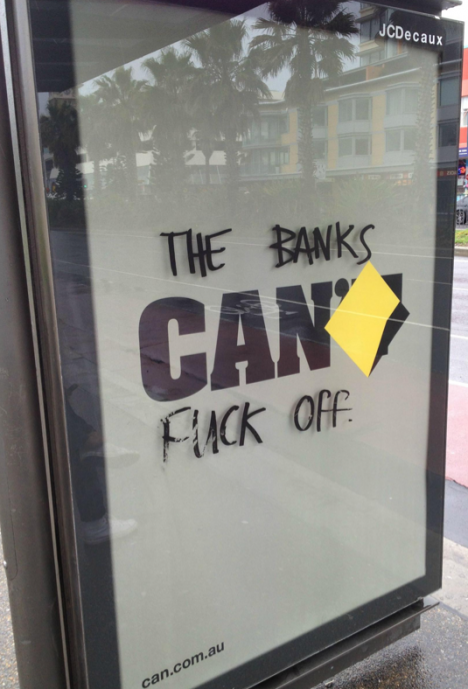
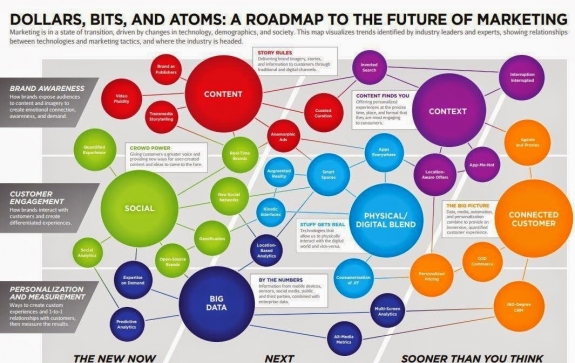



Scan the QR code for our contact details.
Download the Neoreader app.
© COPYRIGHT 2013 UNO marcomms Privacy